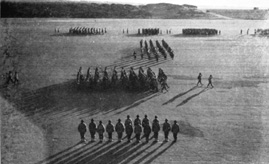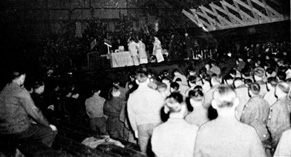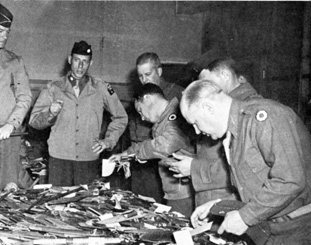Chapter II
Last Days in the U. S.
IMMEDIATELY on the heels of the Martha’s Vineyard maneuvers came the first major movement of the brigade. The winter months on Cape Cod would be too cold to permit year-round boat training so a search for a more suitable training site in a more favorable climate had been under way for several months. With the exception of the 542nd EBSR, all units of the brigade participated in the move. When the hint of moving was first received, discussions arose among brigade personnel about the proposed destination. Some said that the brigade was sure to go to Ireland, some said to the West Coast, but those “in the know” said “Carrabelle.” Then there was an immediate flurry of maps as each one tried to show another the exact location of Carrabelle. Fingers pointed to a spot sixty miles south of Tallahassee, Florida, on the northern gulf coast. Everyone envisioned palm trees swaying back and forth in the cool gulf breezes and the prospect of a warm winter in Florida, the millionaire’s paradise. What a surprise was in store for them!
The men reported that the train ride down to the new camp area was not so bad “if you didn’t mind being crowded into day coaches and breathing coal dust for three days.” Some of the LCVs and LCMs made the journey under their own power through the inland waterway. This proved excellent training in navigation and boat operation over a long distance. However, it cannot be compared with the longer trips over much rougher seas that the boatmen later experienced along the New Guinea coast. The majority of the boats were deck loaded on flat cars and sent by rail. The residents of Georgia were astounded to see four solid trains loaded with boats pass through their cotton fields.
Then came the big surprise! Carrabelle did have palm trees and cool breezes (at times), but it also had rain, mud, swamps, lizards, chiggers, snakes, wild hogs, deer, flies, mosquitoes, sand fleas and wilderness. The cantonment-type camp we had been told to expect was almost nonexistent. The following weeks can best be described in one word - rough. The job of setting up a new camp in this wilderness was no picnic. Three years later after the brigade had had plenty of experience and reached the point of proficiency in building camps, that particular job still couldn’t be considered pleasant. But at Carrabelle everyone pitched in to help build roads, barracks, latrines and mess halls until the camp was fairly well established and “normal” life could be resumed and training started on the shallow beaches and sandy reefs of the Gulf of Mexico.
Those individuals possessed with a desire to get out of camp - and who wasn’t? had the “pleasure” of visiting Appalachicola, Carrabelle, Sopchoppy, and other “quaint” settlements. Wakulla Springs, the home of the Tarzan movies, and Tallahassee, the home of the Florida State Teachers College for Women, held major attractions for the Amphibs. Needless to say, both were very enjoyable.
A training directive issued by the Engineer Amphibian Command called for the brigade remaining at Carrabelle until April 1943 to serve as a training brigade in the preparation of infantry troops for amphibious combat. The Army Ground Forces established an “ Amphibious Training Center” adjacent to the brigade’s area so everyone began to settle themselves down for a pleasant winterland also a lot of work in the warm Florida climate. Preliminary conferences were held with the 38th Infantry Division relative to maneuvers between camp and Dog Island a few miles offshore. A tentative training program for these combined operations was outlined and schedules prepared for the combined training. The Boat Maintenance Company was busy unloading the boats and setting up its repair shops at Camp Belle a few miles from the brigade camp.
Then came the second big surprise! All plans were immediately cancelled when General Heavey received sudden orders to move his brigade to Fort Ord, California, where it would stage for shipment on the first available transports to the Asiatic-Pacific theater of operations.
This abrupt change of plans naturally caused feverish activity with regard to both the many details involved in the movement and the personal affairs of the brigade members. It is said many marriages were moved forward. All boats were turned over to the 3d Brigade which was being moved to Carrabelle to replace the 2d Brigade in the proposed training program. There was every reason to believe that the Brigade would be in Ford Ord for only a few days, so those Easterners who had brought their families to Carrabelle in anticipation of a pleasant winter decided not to take them to California. For many the farewells exchanged in Florida were the final ones for the war and for some the last of all.
The first few days of November, 1942, found the entire brigade enroute from Carrabelle and Cape Cod to California in nine different trains on three different routes. This was an intimation of how the brigade would later be spread to the four winds in its wide-flung operations. Many of the men got their first glimpse of the wonders of the west during this trip. The Pullman accommodations, while not up to peacetime standards of luxury, were, nevertheless, quite comfortable and most of the men found the trip highly enjoyable. It was much better than the trip from Cape Cod to Carrabelle. Daily stops for exercise on station platforms along the way broke the monotony of continuous riding. However, it is probable that most of the men never fully appreciated the comfort of American train travel until a few months later when they were wheezing along the northeastern coast of Australia in one of the narrow-gauge coaches of a train which, by comparison, was reminiscent of the early American stagecoach. The 542nd Engineer Boat and Shore Regiment under Lieutenant Colonel Kasper rejoined the brigade proceeding direct from Cape Cod to Fort Ord. Once again the entire brigade was together.
Fort Ord turned out to be a model garrison with comfortable steam-heated barracks, paved roads, surfaced drill field, excellent bivouac areas immediately adjacent to the camp area, movie theatres, post exchanges, laundry service, and even good rifle, pistol, and machine gun ranges all available on the post. So different from Carrabelle! It was ideally located on the middle California coast north of Monterey Bay and nestled between the fertile, picturesque Salinas Valley truck-farming district and the broad beach of the blue Pacific shore line. The towns of Salinas, Monterey, and Carmel, the latter a well-known artist’s retreat with quaint picture-book architecture and an “arty” atmosphere, were close by and very hospitable to the Amphibians. The famous Hotel Del Monte, scene of many national and international golf tournaments, with its rambling buildings and beautiful grounds, was only four miles south of the camp. The scenic seventeen-mile drive along the shore and through the wooded interior of Monterey Peninsula was unforgetable. A soldier lucky enough to draw a three-day pass could have his choice of taking in either the wonders of Los Angeles and Hollywood or of San Francisco. It is little wonder that, only a few months later in the mud and heat of the New Guinea jungle, men of the 2d Brigade reminisced, almost reverently, of their favorite campaign of the war “the Battle of Carmel.” No one had to tell them who had won that one, and there were no casualties.
In addition to the pursuit of pleasures there was, naturally, work to be done at Ford Ord. The procurement of all authorized equipment, supplies, and personnel and preparing them for overseas shipment were the main problems. The strict overseas physical examination hit the brigade hard. Several hundred had to be transferred out to “limited service.” This resulted in an influx of as many new replacements to fill these vacancies. It was, as someone remarked, “All very confusing, but exciting.” As the work progressed - and delaying orders were received - it became apparent that, instead of a brief stopover of a few days, the brigade might be stationed at Fort Ord until Spring, A number of officers and men, gambling against an early departure, sent for their wives and families and rented living accommodations for them in one of the surrounding communities.
The continuation of a training program presented some rather difficult problems. Most of the equipment needed for proper training had already been sent to the Port of Embarkation or had to be kept packed and ready for early shipment. As no one could say definitely when the brigade would leave, there was doubt as to whether or not any projected schedule of training could be completed when once begun. A few old-style landing barges were available at the Presidio of Monterey and arrangements were made for the boat companies to use them by rotation so they wouldn’t forget entirely what they had learned during those long days of training at Cape Cod. The rifles, pistol, and machine-gun ranges were in almost constant use as unit after unit took turns at a “day on the range.” Cargo nets were hung over high wooden frames made to resemble the hull of a ship, and men were trained in the proper methods of scaling and descending these nets, for no one could tell when or how rapidly he might have to abandon ship in the mid-Pacific. Overnight hikes to the nearby bivouac areas were frequent. This was to provide training in the establishment of field camps and to give every man an idea of the rigors of “camping out.” One of these nights will be long remembered. Camp was made after dark and it was not until daybreak that it was discovered that the camp area was covered with poison oak. The resulting “casualties” were high but did not approach those caused by the “jungle rot” we were later to fight in New Guinea.
Units were given close and extended order drill almost daily. Demonstrations were arranged to explain to all personnel the use of rubber life rafts, how to properly waterproof vehicles, how to identify friendly and enemy aircraft, how to fire rifle grenades and to toss the hand grenade. A five-week’s course in antiaircraft gunnery, under the direction of Captain (later Lt. Col.) Elmer P. Volgenau, of Clarence, New York, was held on the parade ground. Three thousand officers and enlisted men were taught all about machine guns and how to fire them at enemy planes. Every day for over a week, A-20’s and P-40’s would swoop down realistically out of the clouds and skim a few feet over the heads of the gunners who tried to keep them within their sights and knock them out with their simulated fire. Three years later the total number of actual enemy planes the brigade had shot down was sufficient evidence to prove that this training was not in vain. Probably its major value was the confidence it gave our men.

Fort Ord, California. Christmas Day, 1942.
Brig Gen Heavey and Col. Fitch, Commanding
Officer of Fort Ord, review the entire Brigade.

Fort Ord, California, Christmas, 1942.
Christmas Mass.

Gen Heavey and Lt Col Simpson inspect
knives donated to 2 ESB at Fort Ord, California
The 2d Brigade was the first army unit to introduce and have actual training in the use of the “Duck.” These two and a half ton amphibious vehicles, designed and manufactured by General Motors Corporation with the model number “DUKW,” but promptly nicknamed “Ducks, created a great deal of excitement when they first made an appearance on the roads of Fort Ord. Essentially a steel-hulled six by six truck formed into a boat with propeller and rudder superimposed on the stern, it was designed for short water crossings and for the unloading of ships anchored at sea, While at Fort Ord a rigid course in the operation and maintenance of these vehicles was conducted for the brigade personnel by representatives of General Motors Corporation. Defects found in this strenuous training period were corrected in future construction contracts.
This period of garrison duty gave the unit athletic officers a chance for some organized athletics. Every Thursday night a grand evening of boxing was presented. The friendly rivalry between the units did much to cement them into a solidified brigade. All were astonished to find such fine fighters in the brigade. The Amphibians established their reputation as a fighting brigade. Lieutenant (later Major) Arthur L. Barrett of Flushing, New York, had much to do with staging these successful shows.
That there was a deeply religious feeling in the brigade was evidenced by the Christmas Eve services. Chaplain Henry S. Stout of Tampa, Florida, had a large congregation for his Protestant services. At midnight Chaplains Leonard A. LeClair, of Lewiston, Maine, Paul J. Hallinan, of Painesville, Ohio and Raymond 0. Mejer of Sharon, Pennsylvania, held Solemn High Mass for over three thousand members of the brigade. Corporal James G. Morgan Jr., Brigade Headquarters Company of Swedesboro, New Jersey, organized a choir which deeply impressed all present. Thought was given to the difficult, unknown days ahead of us. No one could foresee that this choir was destined to broadcast from the Philippines on Xmas eve of 1944.
On Christmas Day, 1942, General Heavey reviewed the entire brigade on the Fort Ord Parade Ground. It was the first opportunity the brigade had had to hold a review of this size and every effort was expended to make it a success. Colonel Fitch, the Commanding Officer of Ford Ord, reviewed the parade with General Heavey. The neat appearance of the men wearing their steel helmets, paraboots, and overcoats made a deep impression on every visitor present, and from the remarks overhead in the barracks later, there were few Amphibs who didn’t get an inner thrill in having been a participant in the parade that day. It was the first parade in the American Army in which an Amphibian Truck Company rolled by in its “Ducks.” It was commanded by Captain (later Lt. Col.) Cecil R. Bilger of King Fisher, Oklahoma, On its guidon was proudly displayed “Donald Duck, 2 ESB.”
Shortly after Christmas, through the kind efforts of the local newspapers, the citizens of the neighboring communities voluntarily contributed an assortment of over fifteen hundred hunting knives of all descriptions to the Amphibs to be used in their coming attack on the Japs. Within six months some of these knives had been driven into live Japs. A few months after the brigade had departed Fort Ord they were pleasantly surprised to learn that the terrace adjoining the hill on which the Brigade Headquarters had been located was renamed “Amphibian Terrace” in honor of the Second Brigade.
After the holiday season had passed, work on preparations for shipment overseas was intensified. Final embarkation orders were received in mid-January, 1943, and there was a rush on the post exchanges to buy last-minute supplies of personal items until barracks bags bulged. There were a few final inspections and other bits of “unfinished business,” both on and off the post, to complete. Then, in the cool of Sunday morning, January 24, 1943, the first trainload of Amphibians took the northbound express to the Port of Embarkation at San Francisco. Others followed in the next few days. We were pleased to learn later that the Inspector General at the Port officially reported that the units of the Brigade impressed him as the most efficient which had passed through that port in the year he had been at that port.
|